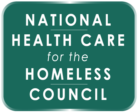Menu: HCH | A Vision of Health for All – Pages
Health Care for the Homeless: A Vision of Health for All
Introduction
This report is a synthesis of findings gathered from a variety of sources. Background books, journal articles, and reports were consulted for information on the roots and development of the national Health Care for the Homeless (HCH) movement, including an annotated timeline created by the National Health Care for the Homeless Council (NHCHC).
The principal source is the proceedings of an “HCH Pioneers” Special Session held in conjunction with the annual National Health Care for the Homeless Conference and Policy Symposium held in Portland, Oregon, from May 31-June 3, 2016. The four-hour session was titled, “HCH Pioneers Explore the Past and Address the Future of HCH.” This was planned as an interactive event with consecutive panels of long-time leaders in HCH discussing the following:
- The vision and values of the HCH movement with its balanced commitments to direct service, policy advocacy, consumer involvement, and ending homelessness.
- The evolution and development of the HCH model of health care, including what factors contributed to the changes, and how the HCH model fits within the current health care environment.
- The impact of HCH in terms of improved health of the homeless population, influence on other social justice movements, and influence on the U.S. health care system.
- Ongoing and future work of HCH, such as the changing role of HCH within the rapidly evolving health care environment, the work of HCH to end and prevent homelessness, and the mandate for HCH leaders moving forward.
Between the panel presentations, two table discussions and large-group feedback time periods were scheduled, with each table having an HCH Pioneer long-time leader as the small group facilitator. Forms were provided at each table for participants to record their thoughts on each of the four session content discussion areas, and people were asked to include their names, phone, and e-mail addresses for possible follow-up clarification or elaboration of their notes. Due to time constraints, with panelists exceeding their scheduled time allotments, only one of the table discussions was accomplished.
Out of a total of 140 session participants and 12 tables, we received a total of eight completed forms, two of which were from table discussion summaries. One of the individual forms was from a person who read his responses to the group during the large-group feedback time; therefore, it was duplicative information.
The author of this report, Josephine Ensign, took hand-written notes during the session, focusing on recording nonverbal cues of the speakers and audience members during the session, as well as other observations in order to add contextual information to the audio-recording and participant written forms.
After the Pioneers Session, Ensign listened to the audio-recording of the session, read the participant forms, and wrote expanded field notes of the session. Drafts of these expanded field notes were shared with John Lozier and Barbara DiPietro, who directs the policy and advocacy activities for the National HCH Council, for their changes and additions. In addition, Ensign contacted people for clarification of their comments during the session.

